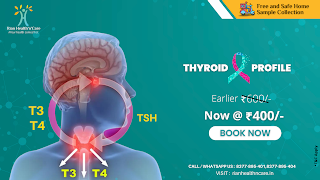What is Thyroid, and What are the Symptoms ?
What is Thyroid ?
Your thyroid gland carries out several tasks, from metabolism to brain growth. Thyroid hormones are necessary for your body's cells to carry out their specific tasks. Two hormones are produced by the thyroid gland:
Thyroxine 90% (T4)
Triiodothyronine, 10% (T3)
Your thyroid is not secreting enough hormones if it is underactive. Hypothyroidism symptoms might result from this. Hyperthyroidism is brought on by an overactive thyroid that secretes too many hormones.
The amount of hormones may be measured with the aid of thyroid function tests (TFTs). They also aid in determining how well the thyroid gland is working.
Thyroid function tests (TFTs) are what, exactly?
A TFT is a set of blood tests used to identify or keep track of different thyroid problems. These tests are included:
Test for thyroid-stimulating hormone (TSH test)
Test for thyroxine (T4 test)
Test for triiodothyronine (T3 test)
Your doctor could also suggest having thyroid antibodies tested.
In general, doctors advise a TFT if you have thyroid disease symptoms. TFT may help diagnose each case more precisely because there are several potential reasons of thyroid issues.
The pituitary gland, which promotes the synthesis of thyroid hormones, or the gland itself may be the source of the issue. TFT may assist in locating the illness.
TSH Test: The most frequent test used to diagnose thyroid problems is the TSH test. TSH is frequently misunderstood to be the thyroid gland's hormone. But the pituitary gland in the brain produces and releases the hormone TSH.
The thyroid gland is stimulated by this hormone to create T3 and T4 hormones. TSH, to put it simply, ensures that thyroid hormones are released into the bloodstream when they are needed. It does this by keeping track of the thyroid hormone level and stimulating the gland appropriately.
TSH Test: The most frequent test used to diagnose thyroid problems is the TSH test. TSH is frequently misunderstood to be the thyroid gland's hormone. But the pituitary gland in the brain produces and releases the hormone TSH.
The thyroid gland is stimulated by this hormone to create T3 and T4 hormones. TSH, to put it simply, ensures that thyroid hormones are released into the bloodstream when they are needed. It does this by keeping track of the thyroid hormone level and stimulating the gland appropriately.
Before beginning thyroid therapy, a TSH test is frequently indicated as the first step. The thyroid function test is often the first one carried out when individuals exhibit signs of thyroid illness.
When the level is greater, the thyroid is being more stimulated by TSH to create T4 hormones. Levels greater than 4.5 mIU/L may signify hypothyroidism.
When the level is below normal, it might indicate that the T3 and T4 levels are elevated. As a result, the thyroid gland's stimulation is being reduced by the body. A hyperthyroid state may be indicated by levels under 3.5 mIU/L.
TSH levels by themselves, though, are insufficient. More testing are required in order to properly interpret the results.
T4 Test: Thyroxine, often known as T4, is the main hormone that the thyroid gland produces. T4 exists in two different forms in the body:
In adults, the typical TSH range is 0.5 - 4.0 mIu/L.
Bound T4
Free T4
Since bound T4 is bound to proteins, the body cannot use it. It is free T4 that really carries out metabolic processes in the body.
The bound state is where more than 95% of the body's T4 is located. Only 5% of it is free T4, which the organs and tissues can utilise.
During a complete T4 test, both free and bound T4 are measured. However, a free T4 test just calculates the level of free T4 in the blood.
Total T4 levels in adults should be between 5 and 12 mcg per deciliter of blood. Additionally, the range of free T4 in healthy blood is between 0.8 and 1.8 (ng/dl). Anything outside or inside the range suggests a thyroid issue.
In hypothyroidism, high TSH levels are typically accompanied by low levels of total T4 and free T4.
T3 tests: Triiodothyronine hormone, often known as T3, makes up just around 10% of the hormones that the thyroid gland produces. The hormone required by the body, T3, is in its active form. As a result, even T4 must be transformed to T3 in order to operate.
T3 comes in two different forms in the body, much as T4.
Linked T3
Free T3 While free T3 is available and used by cells, bound T3 is bound to transport proteins.
Total T3 levels should be between 75 and 195 ng/dl. Free T3 levels are typically between 0.2 and 0.5ng/dl.
A person may have hyperthyroidism if their TSH level is low and their total and free T3 levels are high.


Comments
Post a Comment